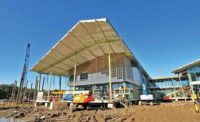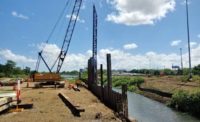Inevitably, the levees will have to be raised again. In most locations, the levees can’t be built up several additional feet because the soil conditions are so poor they would fail under their own weight, or the footprint would be so large the cost for additional right-of-way would be exorbitant, Turner says.
And in some areas, such as eastern New Orleans, adding more height to the levees will prove to be a technical challenge because of the slope of the levees (1 on 2.8) and the soil mixing that had to occur to build them, he said.
Baton Rouge-based Evans-Graves Engineers is the authority’s program manager for the lifts, and HNTB is performing some preliminary work.
Call for Re-evaluation
Bob Jacobsen, a Baton Rouge-based engineer with a focus on surge modeling and a consultant to the state and regional levee board, questions whether even the 100-year system would protect the city from a 100-year storm. He’s pushing for a re-evaluation of the levee system by 2018 to take into consideration not only environmental changes but also changes in surge-modeling technology since 2005.
The current system still has “tremendous uncertainty,” Jacobsen says. “It’s still a question of what is a 100-year storm.”
He calls it almost the definition of a 100-year storm a scientific “guesstimate” based on just 60 years of data. The storm surge for a 100-year storm at the lakefront, he said, could vary between 8 and 15 ft.
Jacobsen said on average, the area is going to have a Category-2 hurricane or severe flooding once every 30 to 50 years.
And potentially a weak link in the system that protects the region will fail.
“We ought to find it,” Jacobsen says.
Reclaiming Wetlands
Many, however, are not counting on the system alone—certainly not beyond its 50-year life expectancy.
“If we don’t look after the coast, this is really not sustainable in the long term,” says Park of the Corps.
The state’s $50-billion coastal master plan, buoyed by oil giant BP’s compensation payments put in place after the 2011 Deepwater Horizon oil spill, is intended to rebuild marsh, wetlands and barrier islands.
That buffering of the coastline is part of a “multiple lines of defense” strategy being promoted by a “Restore the Delta” coalition that is pushing to restore the coast for environmental reasons and to give the region more protection from hurricanes.









Post a comment to this article
Report Abusive Comment